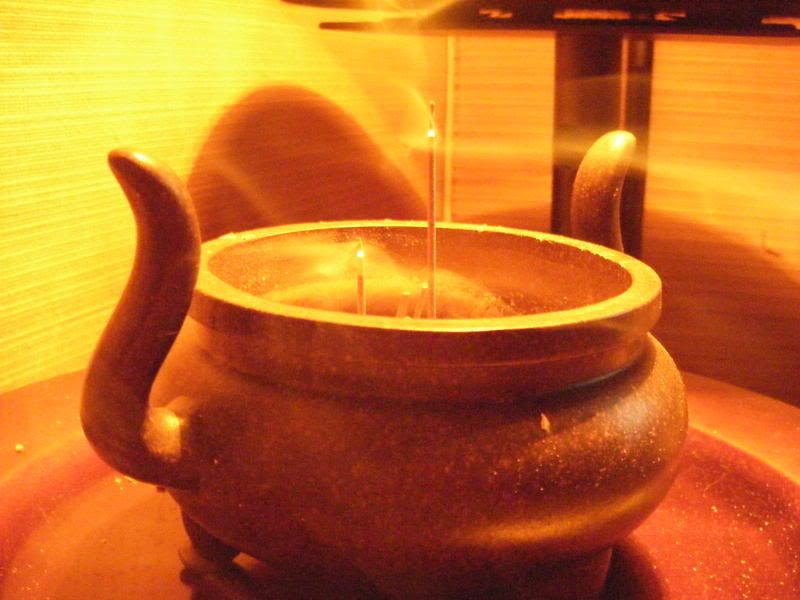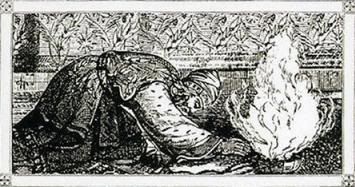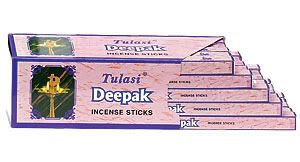I recently purchased a large number of Indian incenses for sampling. I was mainly interested in Mysore Sughandi, hoping to find another hidden Laxmi Dhoop. I also took the opportunity to sample as many different incenses as I could find by Padmini, Nandi, Sarathi and a whole bunch more. I am still making my way through that huge lot, but already I have found one that will be a permanent resident in my incense stash: Tulasi Deepak by Sarathi. "Deepak" is a Hindi and Sanskrit word meaning "little lamp". This incense is aimed at reproducing the smell of a burning oil lamp. This may initially conjure images of choking smoke, but the result is anything but hazy. Deepak exudes a deep, warm, honey-like smell that is completely enveloping. I imagine an amber lamp glowing in some dark corner of an Indian temple. I burned through my sampler pack in a matter of days, and ordered an entire carton for replacement. Unfortunately, I could find no ingredients listing for this incense, either on the package or the internet. I am sure this is the typical perfume-based Indian stick, so the "recipe" is probably a trade secret. Deepak sticks are a little bigger than the small, thin Indian sticks you sometimes find, but not as big as say the dry Indian masalas. Deepak is similar to Nandi Golden Incense (another favorite), and if you are a fan of that brand you will certainly love Deepak, which I find to be even richer and deeper than Nandi Golden.
Saturday, May 16, 2009
Tulasi Deepak
I recently purchased a large number of Indian incenses for sampling. I was mainly interested in Mysore Sughandi, hoping to find another hidden Laxmi Dhoop. I also took the opportunity to sample as many different incenses as I could find by Padmini, Nandi, Sarathi and a whole bunch more. I am still making my way through that huge lot, but already I have found one that will be a permanent resident in my incense stash: Tulasi Deepak by Sarathi. "Deepak" is a Hindi and Sanskrit word meaning "little lamp". This incense is aimed at reproducing the smell of a burning oil lamp. This may initially conjure images of choking smoke, but the result is anything but hazy. Deepak exudes a deep, warm, honey-like smell that is completely enveloping. I imagine an amber lamp glowing in some dark corner of an Indian temple. I burned through my sampler pack in a matter of days, and ordered an entire carton for replacement. Unfortunately, I could find no ingredients listing for this incense, either on the package or the internet. I am sure this is the typical perfume-based Indian stick, so the "recipe" is probably a trade secret. Deepak sticks are a little bigger than the small, thin Indian sticks you sometimes find, but not as big as say the dry Indian masalas. Deepak is similar to Nandi Golden Incense (another favorite), and if you are a fan of that brand you will certainly love Deepak, which I find to be even richer and deeper than Nandi Golden.
Thursday, February 5, 2009
Laxmi Dhoop

Over the past year or so, a little yellow box of incense from India has become my all-time favorite. This may come as a surprise to so-called "incense connoisseurs" (myself included), who routinely pay hundreds of dollars for a few sticks of exotic Japanese incense. Laxmi Dhoop can be found at $1.09 a box. While I occasionally plunk down more than I like for those Japanese brands, I have yet to find anything that consistently beats Laxmi Dhoop.
Laxmi puts out copious smoke, no let me say that differently, Laxmi will set off your indoor smoke alarm. It is far and away the most prolific smoke-producing incense I have ever tried. It is just for this reason that it will put off all but the most patient incense-loving freaks like myself. I only burn Laxmi on days that I will be around the house for hours at a time, preferably all day. It takes about one hour to fully burn one thick, wet "log". And it is best described as a log, about 2 inches long and a quarter of an inch thick, it is a wet, pliable "goo". Getting a Laxmi log to stand on its end can be challenging. It comes with a cheap stand, no more than a flat piece of metal with a little indentation in the middle on which you try to mold the end of a log. I still have trouble even though I've probably done it a hundred times. Always put it in another vessel as tipping over will eventually occur while burning. Lighting Laxmi is another adventure. Once it catches, let the end burn for a minute or two before extinguishing, otherwise it will soon go out. After you've got everything up and running, you will have thick, dense, hazy room of smoke within several minutes. Ventilation will probably be required. I have several fans going myself, and still visibility across the room is noticeably reduced. The scent is one of spicy lavender. I know, I know, "lavender", it can't be good. Somehow, though, it works, at least for me, and I've tried just about every incense out there in the past 20 years. The scent pervades everything and persists for hours, if not days. If you are used to 5 inch sticks of smokeless Japanese brands, you might as well hang it up now, this will knock you off your feet and out the front door.

Laxmi Dhoop is manufactured by the Mysore Sughandi Dhoop Factory in Bangalore, India. They do not list specific ingredients, only saying: "A world of exotic ingredients goes into the making of our agarbattis - sandalwood, flowers, traditional Indian Herbs, perfumes and spices of all kinds." This website lists the ingredients as: gum benzoin, bergamot and lavender, and accurately describes it as "a very strong, slightly resinous aroma". The manufacturer notes that Laxmi Dhoop is "best for summer use", I suppose because you might want to open the windows to let out some smoke.
Friday, October 3, 2008
Kyara showdown: Nippon Kodo vs Shoyeido

The step up in quality I think is dramatic. The rich, dense aroma only hinted at in the Tokusen here takes front and center stage. It's like going from light roast to dark roast coffee. I no longer feel a perfume-based quality, but instead the Gokuhin has an astonishing ability to cut right to the chase, or in this case right to the very rare wood that is kyara. I only wish I could afford to buy a full roll and burn this properly. The 10 minutes or so this lasted were fleeting, and left me wishing for so much more.
Finally, the last stick I have for today is Sho-kaku, or Translucent Path, by Shoyeido. It will be my one and only stick for quite some time, as a roll costs over $500. I will break it into two smaller sticks, which will shorten the burn time but increase the smoke and aroma. First impressions with the Shoyeido are less perfume and more wood. It is sharp and penetrating, vaguely reminding me of citrus at times, but still retaining a distinctive wood flavor. I would have to spend more time with this incense to fully grasp what is happening. At this juncture, though, I would have to declare Gokuhin Kyara Taikan by Nippon Kodo the winner of round one of the kyara showdown. There were no losers.
Thursday, September 18, 2008
Shoyeido in Boulder
I made one of my regular buying trips (more on those later) to Boulder, Colorado yesterday. I've recently been trying Japanese incense and it turns out the corporate headquarters of Shoyeido in the US is in Boulder. They don't make any incense here, it is all imported from Japan, but they do seem to be shipping out of Boulder. The lobby has a small retail space, and this is where I spent about an hour, sniffing and sampling. The prices were identical to the prices of everywhere else, Japanese incense companies seem to control them with an iron hand. So in that respect I was a little disappointed. I knew quite a bit about the Shoyeido line before I ever walked in, more than the very polite and friendly Asian woman who greeted me. For instance, I love Sei-fu, and wanted to try its companion En-mei. Next, I was very interested in the Shoyeido premium line and Horin line, so purchased samplers of each. I was already over my spending limit, but luckily Shoyeido was quite generous with small, free sample packets. I grabbed everything offered, especially if it had agarwood or aloeswood. The free samples definitely made the visit worthwhile. I also spotted some of the discontinued Shoyeido incense heaters on display, apparently the only ones left in stock. I was not ready to plunk down the $179, though I think they would have sold me one if I had asked. I departed with a bag full of incense, and even though most were packed tight, the aroma filled my car the rest of the day. It must have been that one stick of kyara infused Sho-kaku.

I'm only on my fourth stick of En-mei, but will post first impressions. The ingredients list is: sandalwood, patchouli, clove and spices. I can't help but compare to my favorite (so far) Shoyeido Sei-fu. It seems to have a similar base (the "spice" maybe), but otherwise En-mei lacks the penetrating sharpness I like about Sei-fu. It lazily floats around my head with its hazy mix of sandalwood and patchouli, and seems closer to an Indian blend. There is that base though, and I think that tips the scales to the Japanese style. Pleasant enough, but not a stand-out for Shoyeido at this point. Incense has a way of sneaking up on you, though, and a roll of sticks later I might have completely different feelings.

